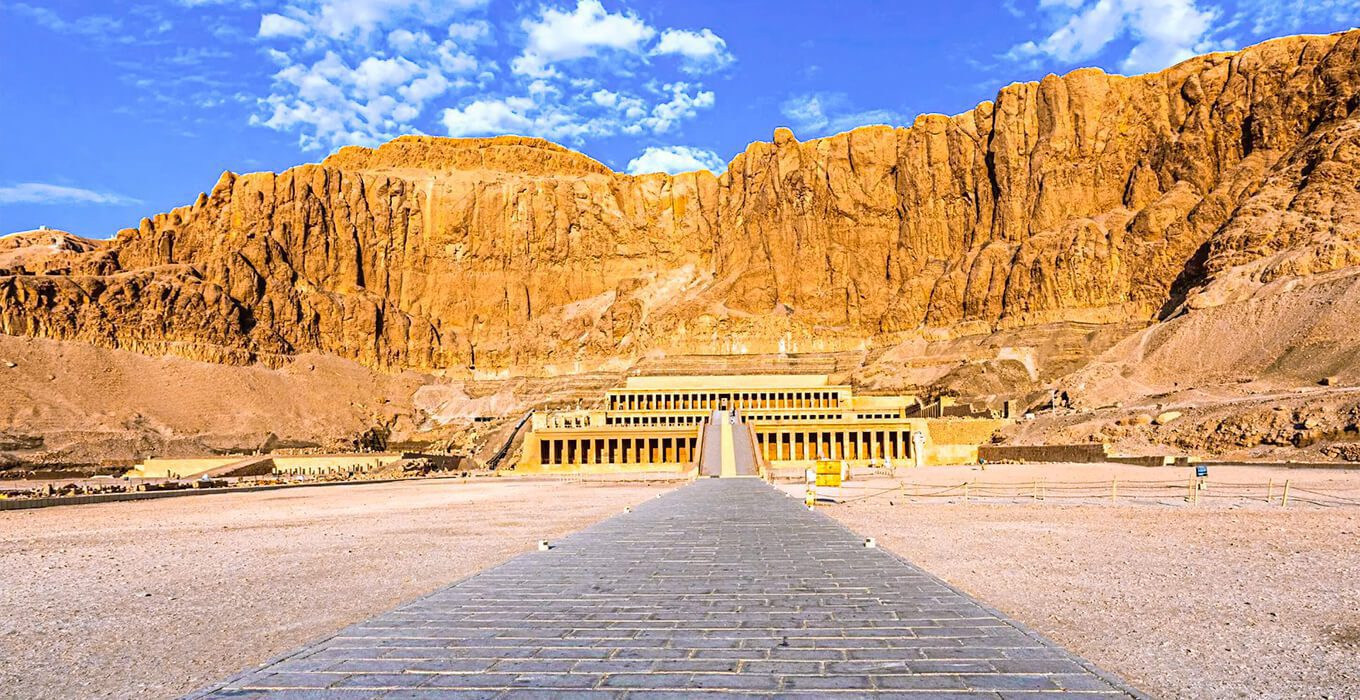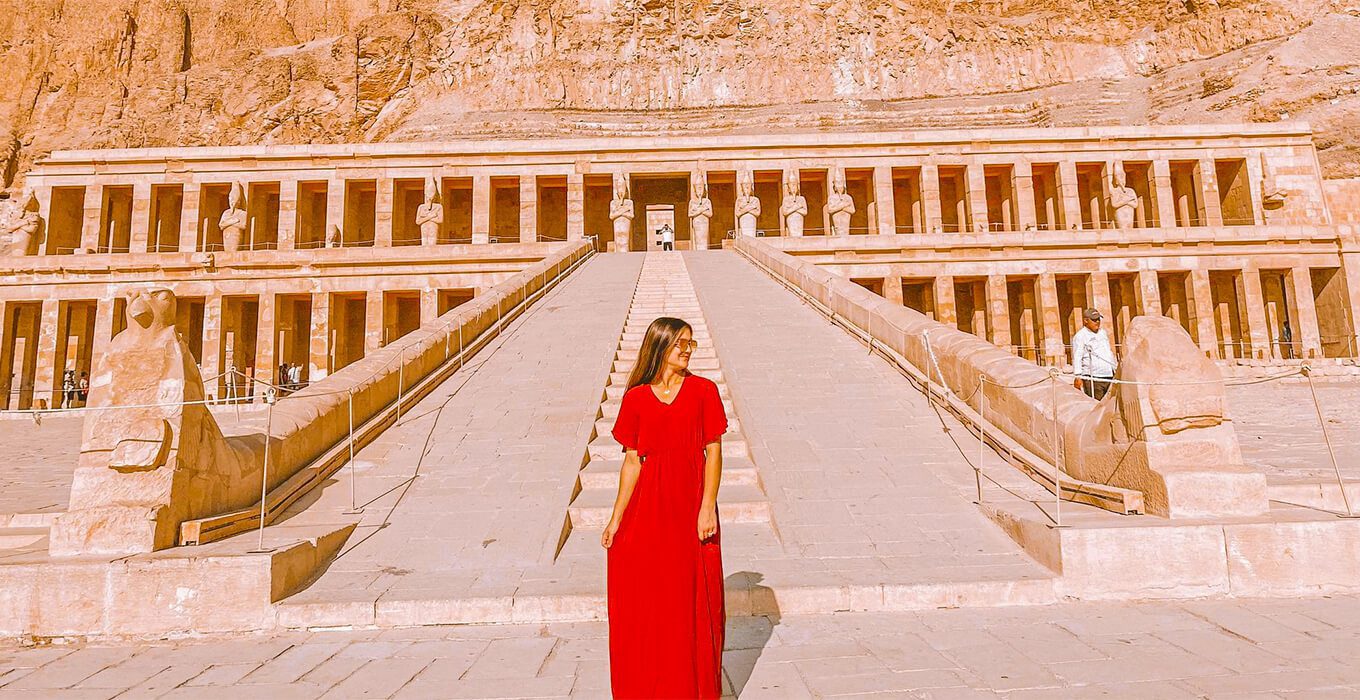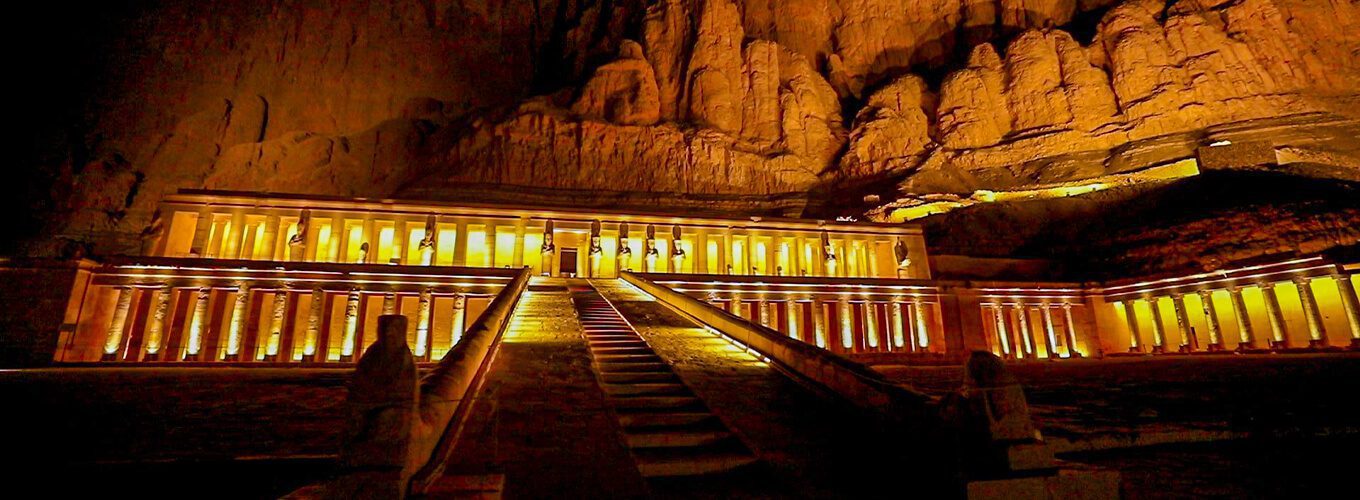Nestled in the heart of Luxor in Egypt, the Hatshepsut Temple stands as a testament to the legacy of one of Egypt’s pivotal female pharaohs, gracing the landscape of ancient Thebes during the illustrious New Kingdom era.
This mortuary temple, an integral part of Luxor’s historical tapestry, unfolds its beauty along the limestone cliffs, tracing the contours behind the Nile Valley. Positioned precisely beneath the cliffs of Deir el-Bahri on the west bank of the Nile, in proximity to the Valley of the Kings, the Temple of Hatshepsut captivates visitors with its multi-tiered architecture, uniquely nestled against the backdrop of the Egyptian landscape.
The final resting place of Hatshepsut, known as Djoser Gesseru, translates to “saint among the saints.” Hatshepsut, a trailblazer as the second female pharaoh after Queen Nefersobek of the Twelfth Dynasty, carved her name into history. Her burial site echoes the extraordinary journey of a woman who ascended to the heights of pharaonic power in a male-dominated era.
This semi-excavated temple is a testament to ancient engineering prowess, defying the conventions of its time. The Temple of Queen Hatshepsut emerges as an iconic marvel in the annals of Egyptian architecture, celebrated for its distinctive design and enduring elegance. Step into history and witness the beauty and resilience of this remarkable structure, a timeless jewel in Luxor’s crown.
Discover the epitome of elegance and refinement with our Luxury Egypt Vacations where every detail is tailored to perfection.
Hatshepsut: A Pioneering Pharaoh in Egypt’s Rich History


Hatshepsut, hailed as one of the triumvirate of Egypt’s greatest pharaohs, ascended to power under unique circumstances. Initially, she served as the wife of Pharaoh Thutmose II. However, her remarkable journey unfolded as she assumed the throne following her husband’s demise, a period during which Thutmose III, her stepson, was a mere child.
Boasting a reign that spanned 22 years, Hatshepsut left an indelible mark on Egyptian history. Thutmose III finally assumed the throne upon her death, but a notable erasure of inscriptions referring to his stepmother occurred. Regrettably, this deliberate act resulted in the loss of various notes and decorations within the Temple of Hatshepsut and other sacred sites.
Despite this historical revision, a silver lining persists. Inscriptions venerating Hatshepsut as a goddess, be it Hathor or Osiris, managed to endure and have reached us today. As both a powerful ruler and a divine figure, Hatshepsut’s legacy continues to captivate and enrich our understanding of Egypt’s storied past.
Embark on an unforgettable adventure with our Luxury Egypt Tours, designed for those who seek the extraordinary.
The Reign of Hatshepsut: A Brilliance in Ancient Egypt’s New Kingdom
In the era of the New Kingdom, the remarkable ascent of Hatshepsut unfolded following the passing of her father, Thutmose I, and her half-brother and husband, Thutmose II, who succeeded the former on the throne. Initially, Thutmose II served as a regent for his wife’s son, but Thutmose III, born of another union, eventually assumed the throne at the tender age of two.
Despite Thutmose III’s early accession, Hatshepsut’s astuteness and political prowess allowed her to retain control over the kingdom until her demise. Her ability to navigate the intricacies of politics solidified her position at the helm of power.
The illustrious mortuary temple she commissioned is a testament to her devotion to the sun god Amun-Ra. Situated near the Temple of Mentuhotep II, both temples were historically esteemed as sources of inspiration and materials for subsequent projects. The Hatshepsut Temple, often heralded as one of the “unparalleled monuments of ancient Egypt,” attests to the enduring legacy of this exceptional ruler in the annals of Egyptian history.
Create your perfect journey with our Egypt Tailor Made Holidays, where every itinerary is as unique as you are.
Hatshepsut fame
Renowned for her distinctive statues, which depicted her wearing the traditional headdress typically reserved for male pharaohs, Hatshepsut stands out as a remarkable figure in Egyptian history. Her fame transcends gender boundaries, not only because she achieved unprecedented power as the sole female sovereign in Egypt but also due to her exemplary governance during her reign.
The enduring testament to her rule is vividly portrayed in the temple constructed in her honor. The images within this architectural marvel showcase Hatshepsut’s prowess as a ruler, illustrating the wisdom and leadership she exhibited during her time on the throne.
Beyond the artistic depictions, Queen Pharaoh left an indelible mark on the Egyptian landscape by commissioning various temples. Among these notable structures is the iconic Karnak Temple, a testament to her commitment to ancient Egypt’s cultural and religious landscape. Hatshepsut’s legacy, etched in stone and inscribed in the annals of history, paints a portrait of a ruler whose impact transcends traditional gender roles.
Planning your ultimate Egypt adventure? Our Egypt Trip Planner is your key to a seamless, unforgettable experience.
The Resurrection of Hatshepsut’s Temple: A Journey of Restoration
Rediscovered in the mid-nineteenth century, the temple of Hatshepsut lay in ruins, a poignant reflection of the deliberate destruction it suffered at the hands of Thutmose III, likely fueled by personal grievances against his stepmother’s memory. The site’s subsequent transformation into a monastery in the first century AD further hastened its decline, necessitating extensive restoration efforts in the 20th century.
The temple’s current condition, which is evident in the incomplete frescoes and rebuilt columns, is a testament to the difficulties encountered during the restoration process. While not fully restoring its original splendor, the temple, a popular tourist destination, carries an air of historical significance.
Central to Hatshepsut’s propaganda was the birth legend, strategically employed to establish her legitimacy as a ruler. Elaborate details of this mythical birth were meticulously illustrated on the temple walls, showcasing her divine right to the throne.
The Majestic Beauty of Hatshepsut’s Mortuary Temple in Deir el-Bahri


Carved into the rock with a facade stretching at least 40 meters wide, the mortuary temple of Hatshepsut in Deir el-Bahri is a colossal architectural marvel. Its primary feature is the integration of three terraces, stacked one atop the other, each housing open courtyards, pillared rooms, and concealed temples within the mountain’s depths.
The connecting element, the slopes, serves as both stairs and a unifying link, dividing the temple into two symmetrical halves—the southern and the northern. Once adorned with diverse flora and expansive ponds, these terraces no longer bear traces of their former glory, including the vast T-shaped pools and the enigmatic garden preceding the sanctuary’s entrance.
Yet, the enduring grandeur of the snow-white columns, crafted from local sandstone, remains untouched. Their impeccable symmetry evokes the splendor of ancient Dorian columns.
In times past, a lengthy alley guided visitors towards the slope of Hatshepsut’s Temple in Luxor, commencing in the desert at the cusp of cultivated fields. The majestic tower marked the journey’s commencement, offering a scenic pathway adorned with myrtle trees from Punt and Sphinxes sculpted to personify the god Osiris in the visage of Hatshepsut. Experience the timeless allure of this ancient masterpiece, where each terrace tells a tale of architectural brilliance and regal magnificence.
UK travelers, your gateway to luxury and history begins with our Luxury Egypt Tours and Holidays from UK. Experience Egypt like never before!
The lower terrace of the Temple of Hatshepsut
The lower floor of Queen Hatshepsut’s mortuary temple in Luxor is encircled by a formidable wall adorned with colossal bird figures, creating a striking visual spectacle. At the termination of this structure, a grand entrance with 22 columns beckons, featuring towering statues of lions and regal monuments dedicated to the queen herself. She is depicted in everyday attire and opulent ceremonial garb, creating a captivating tableau.
The intricately adorned walls of this tier narrate more than the tales of construction and the transportation of stone blocks along the Nile. They unfold a rich tapestry of narratives, chronicling numerous military campaigns and epic battles. Evocative depictions of anacondas and falcons abound, embodying the symbolism of Horus and Wadjet, the revered guardians of Egypt’s two distinct realms. As you explore this lower floor, immerse yourself in the visual symphony encapsulating Queen Hatshepsut’s enduring legacy’s grandeur, history, and symbolism.
American travelers, your adventure into antiquity starts with our Luxury Egypt Tours Packages from USA. Experience Egypt’s legendary sights in unrivaled luxury.
Central terrace of the Temple of Hatshepsut
In the captivating image of Hatshepsut’s temple in Deir el-Bahri, the entrance to the middle tier unveils a grandeur marked by a 12-columned hall and a network of internal enfilades seamlessly integrated into the rock’s thickness.
The door leading to these galleries is a masterpiece, crafted from black copper and adorned with precious metals. Within these chambers, treasures of both material and historical significance await exploration.
The reliefs on this tier narrate the pivotal accomplishments of the female pharaoh, notably her momentous expedition to Punt (modern Somalia). Historical records describe Hatshepsut’s vast and formidable expedition, prompting the swift recognition of the island’s inhabitants as subjects of Egypt.
The meticulous depictions of the ancient rock paintings vividly portray the Egyptian fleet, the local landscape, and the king presenting treasures such as gold jewelry, incense, valuable trees, animal skins, and numerous enslaved individuals.
Related articles:
- Egypt Temples: A Guide to the Country’s Most Iconic Temples
- Ibn Tulun Mosque: A Testament to Islamic Art and Architecture
- Karnak Temple: A Treasure Trove of Mysteries and Legends
- Top 17 Things To Do in Luxor: Luxor Wonder Landmarks
- Luxor Temple: Where History and Mythology Meet
- 14 Days Luxury Tour Cairo
